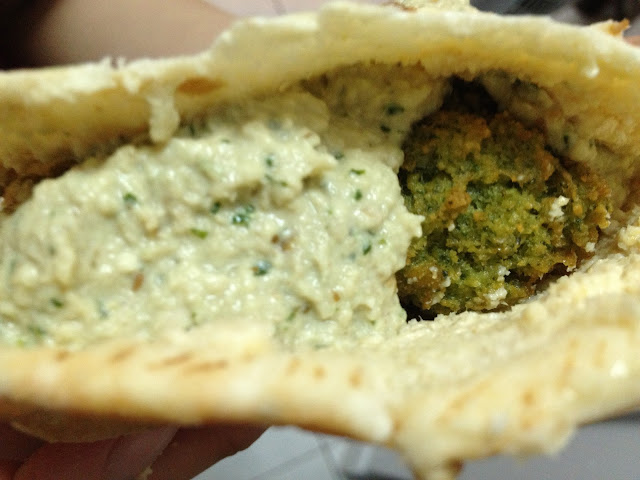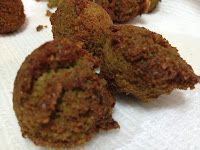When an obscure musician becomes famous, everyone wants to claim being a fan "since they were playing out of their garage." When a trend appears in Vogue, everyone wants to say that they were rocking the style when they were the only one. During the Olympics, people suddenly are filled with patriotism as they see their countries winning medals. People love to claim success, and it is no different with food. Let's take Falafel, for example. Israelis claim it, Palestinians claim it, Egyptians claim it... and I will never forget my disenchantment with Greece after my futile search for falafel in Athens. Yep, the Greeks claimed it too (but were clearly lying to me). Although this "food fight" can be frustrating, it is nice to know that people still get passionate and proud about cuisine.
Some say that the truth must be revealed so that credit is given where credit is due, but I like to think that we can all take joy in "owning" part of these traditions. Although I am Swedish by heritage, American by ethnicity and culture, and Californian by identity, if I develop a delicious recipe inspired by another culture's cuisine, I hope that someday my great grandchildren will say, "That's my awesome, youthful, vibrant, hip great-grandma's recipe, and it is in my blood." I hope that they defend it as part of their identity and respect that others feel the same way.
This week I made falafel, hummus, and baba ganoush, the first two recipes in an Israeli style based solely on the fact that Taïm in NYC makes a killer falafel and the owner, Einat Admony, is Israeli. I followed her recipes for falafel and hummus, memorizing them along with baba ganoush to serve to a large party this week.

About Falafel, Hummus, and Baba Ganoush
Falafel (as well as the sauces served with it) has been a source of pride for some and a source of conflict for many. Countries throughout the Middle East claim falafel as their own, but no two states have a higher profile debate going on than Israel and Palestine.* I explored this debate and found many, many opinions, but some of the more academic opinions caught my eye.The authors of Beyond Hummus and Falafel: Social and Political Aspects of Palestinian Food in Israel argue that falafel is a Palestinian food that became part of Israeli cuisine as naturally as any immigrant cuisine merges with a new country. They write that with the establishment of Israel, Palestinian citizens of Israel kept their own immigrant dishes "in the private sphere, not so much due to the reluctance of the Palestinian population to expose its food as to the suspicions of Jewish people toward Arab food. Some, but only relatively few, of its components were appropriated by Jewish knowledge agents and became identified as 'Israeli' dishes."
Joan Nathan, the author of The Foods of Israel Today, disagrees that falafel originated as a Palestinian food and became Israeli through proximity. The New York Times quotes her as saying, "Falafel is a Biblical food. The ingredients are as old as you're going to get. These are the foods of the land, and the land goes back to the Bible. There have been Jews and Arabs in the Middle East forever, and the idea that Jews stole it doesn't hold any water."
Long story short, when discussing a region where political boundaries have been (and continue to be) so fervently contested, we must remember that the world has gotten smaller since the development of civilization. Overlap and adoption of cuisines is natural, normal, and (I would argue) completely positive. After all, I cannot imagine a world in which I am constrained to consuming nothing but the agricultural resources of the island of Manhattan.
*I have been choosing my wording as carefully as possible so as to not offend readers about something I am still learning about. I have used the word state to refer to both Israel and Palestine. This choice is based on the United Nation's recognition of Palestine as a "non-member observer state" and Israel as a member state.
Choosing the Recipes
I am slightly addicted to the cooking competition show Chopped, which led me to become familiar with chef Einat Admony. She is an Israeli chef and the owner of Taïm Falafel and Smoothie Bar in NYC. Although I had never been to Taïm before planning this meal, I knew from her attitude and positive reviews on Chopped (she won!) that I could expect a delicious meal. I decided to forego my usual weekend Bagel Run™ (my 3-mile run to Absolute Bagels to buy a bagel) for a much longer Falafel Run (trademark pending). I jogged down the West Side Highway and back into the heart of Nolita, where I chugged a bottle of water and ordered a fantastic Green Falafel Sandwich. I knew then that I had chosen my recipes wisely.As for the Baba Ganoush recipe, I must admit, I went with aesthetics. I love a website that is easy to navigate, visually appealing, and clear. Cook, baker, and cookbook author David Lebovitz had the prettiest looking Baba Ganoush recipe I could find, making his the winner despite the fact that his forte is dessert. I modified his recipe quite a bit to fit the use of my new cooking goody, my stovetop smoker. However, I trust that it would be very tasty without the smoking process as well.
Memorizing the Recipes
Mise en place, my favorite fancy French term that makes life trés easy, was the key to this dinner. I chopped, measured, and poured all the ingredients into little containers and set them out for easy mixing when the time came.So many of the ingredients overlap that I feel like a Venn Diagram is in order. Ratios are important (about 1/2 cup tahini for every 4 cups of something else, for instance). The falafel had a surprising amount of salt, and I upped the lemon juice for all of the recipes. Here's the gist, though:
The Verdict
I adore my smoker! It smelled like summer in my apartment, with a woodsy, charred smell perfuming the air without choking us all with smoke. I was blown away by the success... the Baba Ganoush was one of the best I have ever had. Look out for more smoked foods in the future. The hummus remained a bit gritty despite the addition of olive oil, and I wonder if canned garbanzo beans would make a difference. I didn't mind the grit at all but some people like their hummus Sabra-smooth, and this was not. The falafel recipe was true to the restaurant, and it was delicious. I always wonder if chefs publish a slightly less delicious version of their restaurant recipes so that they can never quite be replicated at home. However, Chef Admony gave a marvelous falafel recipe for any home cook to make.Making the falafel into sandwiches was a great way to save some plates (we just ate our sandwiches using a paper towel), and extra side dishes were easy. I set out some baby carrots with extra hummus, dried figs and apricots with honey-drizzled ricotta, and the Israeli salad (parsley, cucumber, and tomato).
The Recipes
Taïm's Green Falafel
Adapted from The Jew and the Carrot, recipe by Einat Admony
Yield: 30 falafel balls (enough for 6 sandwiches)
Ingredients:
- 1 bottle canola oil, for frying
- 2 cups dried chickpeas, soaked overnight and drained
- 1/2 large yellow onion, roughly chopped
- 2 cloves garlic, pressed and roughly chopped
- 1 cup flat parsley leaves
- 1 cup cilantro leaves
- 2-3 fresh mint leaves
- 1 tsp cumin
- 1 tsp ground coriander
- 1 tbsp salt (yes, a tablespoon)
- black pepper, to taste
Preparation:
- Pour 3-4 inches of oil into a deep pot and heat over a medium flame to about 275°F. If you don't have a thermometer, heat until you see swirls develop in the oil, then test the oil by placing a soaked chickpea in the oil. If it sizzles and bubbles start gathering around it, the oil is ready.
- Meanwhile, place the chickpeas, onion, and garlic in a food processor and pulse until a course, moist meal forms.
- Add the remaining ingredients (minus the oil) and continue pulsing until all chickpeas are broken down and the ingredients have combined into a soft, malleable dough (it should have the texture of moist soil).
- When the oil is ready: Using a small cookie dough or ice cream scoop, scoop out a ball of dough and carefully release it into the oil near the side of the pot. Holding the scoop close to the oil helps avoid splashing, but please be careful.
- Repeat with more balls of falafel dough, working your way around the pot in a circle. The number of falafel balls you fry at once will depend on the size of your pot.
- Let fry until the balls float to the surface of the oil and have a light brown, firm exterior (about 4 minutes). Remove with a slotted spoon and place on a paper towel-lined plate.
- Repeat until all dough is used. Serve immediately.
- Cooking oil can be strained and saved in a glass container for future frying. Refrigerate after saving. See further details here.
Hummus
Adapted from Balaboosta Way
Yield: 8 servings
Ingredients:
- 4 cups dried chickpeas, soaked overnight and drained
- 1/2 cup tahini
- 1/2 cup water
- 1/4 cup lemon juice
- 3 cloves roasted garlic
- 1 tsp salt
- 1/2 tsp cumin
- black pepper, to taste
- 1/4 cup extra virgin olive oil (use the good stuff)
Preparation:
- Place all ingredients except the oil into a food processor and blend until smooth.
- While the mixture is processing, drizzle the oil in.
- Garnish with another drizzle of olive oil and some parsley leaves
Smokey, Lemony Baba Ganoush
Adapted from David Lebovitz
Yield: 8 servings
Ingredients:
- 3 medium-sized eggplants, halved lengthwise
- 1/2 cup tahini
- 1 tsp course salt
- 1/4 cup lemon juice
- 3 cloves garlic, pressed and smashed
- 1/8 tsp cayenne pepper
- 1/2 bunch flat-leaf parsley
- Optional: 1 tsp smoked paprika or smoked salt (recommended if you are not using a smoker for the eggplant)
Preparation:
- If using a smoker, follow the manufacturer's instructions. They are quite simple: Add 1 tbsp wood chips to the bottom of the smoker. Place the drip pan and the cooking rack on top. Put the eggplant skin-side down on the cooking rack and close the lid 3/4 of the way. Turn on the stove to medium heat, and once the first wisp of smoke shows, close the lid all the way. Cook for 18 minutes.
- Meanwhile (or if not using a smoker), preheat the oven to 375°F.
- Place the smoked or raw eggplant on a baking sheet and roast for 25 minutes until completely soft.
- Remove from the oven and let cool.
- Scrape out the pulp and place in a food processor with the other ingredients. Puree until smooth.
- Taste and adjust the salt and lemon juice if necessary.
- Drizzle with olive oil to serve.
Assembling a Falafel Sandwich:
1. Spread the entire inside of a pita pocket with hummus (reach down to the very bottom of the pocket)
2. Add 2 falafel balls and press them down to the bottom of the pocket.
3. Add some Israeli salad (tomatoes, cucumbers, and parsley chopped together with a splash of vinegar or lemon juice)
4. Place 3 more falafel balls side by side.
5. Top with baba ganoush and/or tahini.












No comments:
Post a Comment